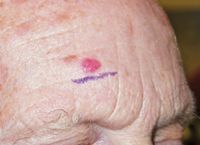- Acne
- Actinic Keratosis
- Aesthetics
- Alopecia
- Atopic Dermatitis
- Buy-and-Bill
- COVID-19
- Case-Based Roundtable
- Chronic Hand Eczema
- Drug Watch
- Eczema
- General Dermatology
- Hidradenitis Suppurativa
- Melasma
- NP and PA
- Pediatric Dermatology
- Pigmentary Disorders
- Practice Management
- Precision Medicine and Biologics
- Prurigo Nodularis
- Psoriasis
- Psoriatic Arthritis
- Rare Disease
- Rosacea
- Skin Cancer
- Vitiligo
- Wound Care
Article
Study defines role for nodal staging in Merkel cell carcinoma
Approaches to treatment of primary Merkel cell carcinoma (MCC) have varied widely, but results of a published study (Schwartz JL, et al. J Clin Oncol. 2011;29(8):1036-1041) support nodal staging as an important component in managing this cutaneous malignancy, according to investigators from the University of Michigan, Ann Arbor.

Key Points
Ann Arbor, Mich. - Approaches to treatment of primary Merkel cell carcinoma (MCC) have varied widely, but results of a published study (Schwartz JL, et al. J Clin Oncol. 2011;29(8):1036-1041) support nodal staging as an important component in managing this cutaneous malignancy, according to investigators from the University of Michigan, Ann Arbor.
The study included 97 primary tumors of 95 patients with MCC who underwent sentinel lymph node biopsy (SLNB). The SLN was successfully detected in 93 cases (96 percent), and at least one positive node was identified in 45.2 percent of the successful biopsies.
Analyses of various clinical and histologic features identified several variables that predicted SLN positivity. Using that information to develop a predictive model showed there was no subgroup of primary lesions where the risk of a positive SLN was felt to be sufficiently low to obviate staging with SLNB, says Christopher K. Bichakjian, M.D., assistant professor of dermatology and director of the multidisciplinary MCC program at the university.

"The results of this study, which show a high success rate in detecting the sentinel node and a high rate of positivity regardless of clinical or histologic features, even for the smallest, thinnest lesions, support that approach," he says.
Clinical analyses
The analyses considered a total of seven clinical variables relating to tumor site and size and patient demographic and history features, along with seven histologic variables. In multivariate analyses, statistically significant correlations were found between SLN positivity and clinical lesion diameter, Breslow thickness, mitotic rate and growth pattern.
"These are not outcomes data. However, we think it provides very important prognostic information that is even more compelling for MCC than melanoma considering results of a study from Memorial Sloan-Kettering Cancer Center (MSKCC) that found the five-year survival rate was 75 percent for patients identified as having localized disease based on clinical staging; 97 percent in those who were node negative by pathology; and only 52 percent if the nodes were positive," Dr. Bichakjian says. "We may not yet be at the point where we can significantly improve survival for MCC, but perhaps with information from SLNB to guide treatment decisions, we can do better at achieving regional control."
Dr. Bichakjian says he hopes that outcomes data on the effect of nodal staging is not far away. "Considering the aggressive behavior of MCC, we hope to have those answers sooner than could be obtained for melanoma," he says.
Study results
In the University of Michigan study, the SLN was positive in 23.8 percent of the MCCs less than 1 cm. The rate more than doubled for tumors measuring 1 cm to 2 cm in diameter (58.6 percent), and it was 68.2 percent for tumors with a clinical diameter greater than 2 cm.
Breslow thickness also had a linear correlation with SLN positivity rate, but even tumors with a Breslow thickness less than 2 mm were associated with a 23 percent rate of SLN positivity. The analyses of mitotic rate showed whether it was less than 10 or 10 to 30, the SLN positivity rate was 36.4 percent, and it increased linearly for tumors with a higher mitotic rate.
For growth pattern, tumors were classified as infiltrative or circumscribed. Not surprisingly, an infiltrative growth pattern incurred a higher risk of SLN positivity (at least two-and-a-half fold), but 30 percent of circumscribed tumors were associated with a positive SLN.
Newsletter
Like what you’re reading? Subscribe to Dermatology Times for weekly updates on therapies, innovations, and real-world practice tips.










